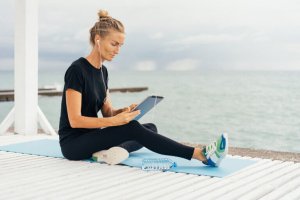School and Sports: How to Find a Balance

The question of how to make school and sports compatible is something that worries athletes, parents, and teachers. Often, people think that school and sports don’t go together. Why do we say that this isn’t true?
There often comes a time in an athlete’s life where he needs to choose one and abandon the other. Also, it’s common for parents, worried about their children’s grades, to prohibit sports until their grades improve.
School and sports are perfectly compatible; in fact, they complement each other and have positive effects on each other. In this article, we’ll explain the benefits of playing sports while going to school, as well as some tips to balance them.
School and sports: training benefits academic performance
There’s a lot of research linking school and sports at all life stages. Here are some examples of how physical exercise increases intellectual performance:
- Improve explicit memory: this type of memory is based on the memory of concepts and events that we can describe. In the brain, it’s mainly located in the structure called the hippocampus. In a study with children, they found that those with greater cardiovascular capacity had a greater volume of the hippocampus. Therefore, they did better on tasks that required explicit memory.
- Increase attention span: a 30-minute aerobic exercise routine before a visual discrimination task has been shown in a Mind, Brain, and Education study to increase attention span in 13-and-14-year-olds.
- Increase cognitive performance: in an experiment with nine-year-olds who took math, reading, and spelling tests, they performed better if they’d previously run on a treadmill for 20 minutes.

- Prevent the brain from aging: the studies in adults and older people say that exercise increases levels of BDNF protein (Brain-Derived Neurotrophic Factor). This protein is involved with creating new synapses, which increases the thickness and density of brain tissue.
- Increase self-control: martial arts have shown to decrease aggressive impulses. Also, they promote prosocial behaviors in children.
Make a study calendar
An effective measure to combine school and sports is to make a calendar to set up study hours. In this, you need to take into account the practice hours, travel time, and prioritize the subjects. In other words, you’ll need to dedicate more hours to the harder subjects and less to those that are easier.
Then, put that calendar in a visible place so you don’t forget it. In addition, if you write down the tasks and the time you’re going to dedicate to them, you’ll be more committed and it’ll be easier for you to complete them.
Be aware and acquire good study habits
Acquiring healthy study habits is essential for any student, especially if you have a few hours to study. Being aware means making the most of your study hours and not distracting yourself.
Study in a clear place, with natural light, and without distractions. Take 15-minute breaks for each hour of study. Just as a physical activity requires warming up, mental activity needs it too. The peak of maximum attention and performance happens 20 minutes after starting a task and starts to drop from fatigue after 50 minutes.
Therefore, start with tasks that aren’t very demanding: underlying, making outlines, summaries… and then memorize them later. Finally, it’s important for the breaks to not be longer than 15 minutes. Otherwise, you’ll lose all the concentration you just gained, and you’ll have to start again from scratch.
Don’t be distracted by things that can wait
When you’re studying, it’s tempting to check your phone or turn on a video game console. However, all these activities will distract you and prevent you from sticking to your schedule.

An effective measure to prevent this from happening is to put any distraction out of your reach. Put your phone in a drawer, on top of a shelf, or in another room. If you have to make an effort to grab it, you’re less likely to resort to it.
Use those leisure activities as a reward only after completing your schedule. This is what’s known in psychology as Premack’s Principle: getting something desirable after doing a less pleasant activity reinforces that less appetizing activity.
Disconnect from studies during workouts
Many times, worries creep into all areas, but excessive worry only has negative consequences. Clear your mind of academic concerns when you’re training, and focus on what training requires.
Use that rest period to disconnect and relax. This way, you’ll be able to study with a carefree mind, and you’ll do better.
School and sports: conclusion
With all this, we’ve seen that school and sports are not two things to choose between, but rather complement each other and fit perfectly. With the help of study habits, a homework schedule, and good discipline to stick with it, you’ll have plenty of time to study and train every day.
The question of how to make school and sports compatible is something that worries athletes, parents, and teachers. Often, people think that school and sports don’t go together. Why do we say that this isn’t true?
There often comes a time in an athlete’s life where he needs to choose one and abandon the other. Also, it’s common for parents, worried about their children’s grades, to prohibit sports until their grades improve.
School and sports are perfectly compatible; in fact, they complement each other and have positive effects on each other. In this article, we’ll explain the benefits of playing sports while going to school, as well as some tips to balance them.
School and sports: training benefits academic performance
There’s a lot of research linking school and sports at all life stages. Here are some examples of how physical exercise increases intellectual performance:
- Improve explicit memory: this type of memory is based on the memory of concepts and events that we can describe. In the brain, it’s mainly located in the structure called the hippocampus. In a study with children, they found that those with greater cardiovascular capacity had a greater volume of the hippocampus. Therefore, they did better on tasks that required explicit memory.
- Increase attention span: a 30-minute aerobic exercise routine before a visual discrimination task has been shown in a Mind, Brain, and Education study to increase attention span in 13-and-14-year-olds.
- Increase cognitive performance: in an experiment with nine-year-olds who took math, reading, and spelling tests, they performed better if they’d previously run on a treadmill for 20 minutes.

- Prevent the brain from aging: the studies in adults and older people say that exercise increases levels of BDNF protein (Brain-Derived Neurotrophic Factor). This protein is involved with creating new synapses, which increases the thickness and density of brain tissue.
- Increase self-control: martial arts have shown to decrease aggressive impulses. Also, they promote prosocial behaviors in children.
Make a study calendar
An effective measure to combine school and sports is to make a calendar to set up study hours. In this, you need to take into account the practice hours, travel time, and prioritize the subjects. In other words, you’ll need to dedicate more hours to the harder subjects and less to those that are easier.
Then, put that calendar in a visible place so you don’t forget it. In addition, if you write down the tasks and the time you’re going to dedicate to them, you’ll be more committed and it’ll be easier for you to complete them.
Be aware and acquire good study habits
Acquiring healthy study habits is essential for any student, especially if you have a few hours to study. Being aware means making the most of your study hours and not distracting yourself.
Study in a clear place, with natural light, and without distractions. Take 15-minute breaks for each hour of study. Just as a physical activity requires warming up, mental activity needs it too. The peak of maximum attention and performance happens 20 minutes after starting a task and starts to drop from fatigue after 50 minutes.
Therefore, start with tasks that aren’t very demanding: underlying, making outlines, summaries… and then memorize them later. Finally, it’s important for the breaks to not be longer than 15 minutes. Otherwise, you’ll lose all the concentration you just gained, and you’ll have to start again from scratch.
Don’t be distracted by things that can wait
When you’re studying, it’s tempting to check your phone or turn on a video game console. However, all these activities will distract you and prevent you from sticking to your schedule.

An effective measure to prevent this from happening is to put any distraction out of your reach. Put your phone in a drawer, on top of a shelf, or in another room. If you have to make an effort to grab it, you’re less likely to resort to it.
Use those leisure activities as a reward only after completing your schedule. This is what’s known in psychology as Premack’s Principle: getting something desirable after doing a less pleasant activity reinforces that less appetizing activity.
Disconnect from studies during workouts
Many times, worries creep into all areas, but excessive worry only has negative consequences. Clear your mind of academic concerns when you’re training, and focus on what training requires.
Use that rest period to disconnect and relax. This way, you’ll be able to study with a carefree mind, and you’ll do better.
School and sports: conclusion
With all this, we’ve seen that school and sports are not two things to choose between, but rather complement each other and fit perfectly. With the help of study habits, a homework schedule, and good discipline to stick with it, you’ll have plenty of time to study and train every day.
All cited sources were thoroughly reviewed by our team to ensure their quality, reliability, currency, and validity. The bibliography of this article was considered reliable and of academic or scientific accuracy.
- Chaddock, L., Erickson, K. I., Prakash, R. S., Kim, J. S., Voss, M. W., VanPatter, M., … y Cohen, N. J. (2010). A neuroimaging investigation of the association between aerobic fitness, hippocampal volume, and memory performance in preadolescent children. Brain research, 1358, 172-183.
-
Hillman, C. H., Pontifex, M. B., Raine, L. B., Castelli, D. M., Hall, E. E., y Kramer, A. F. (2009). The effect of acute treadmill walking on cognitive control and academic achievement in preadolescent children. Neuroscience, 159(3), 1044-1054.
-
Kubesch, S., Walk, L., Spitzer, M., Kammer, T., Lainburg, A., Heim, R., y Hille, K. (2009). A 30‐minute physical education program improves students’ executive attention. Mind, Brain, and Education, 3(4), 235-242.
- Orozco-Calderón, G. (2015). Cerebro y artes marciales: beneficios, riesgos e intervención neuropsicológica. Ciencia & Futuro, 5(4), 142-156.
- Ramírez, W., Vinaccia, S., y Gustavo, R. S. (2004). El impacto de la actividad física y el deporte sobre la salud, la cognición, la socialización y el rendimiento académico: una revisión teórica. Revista de estudios sociales, (18), 67-75.
This text is provided for informational purposes only and does not replace consultation with a professional. If in doubt, consult your specialist.








